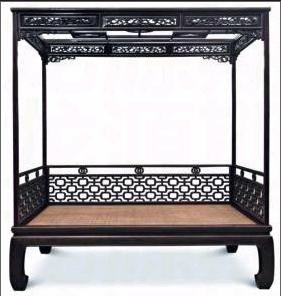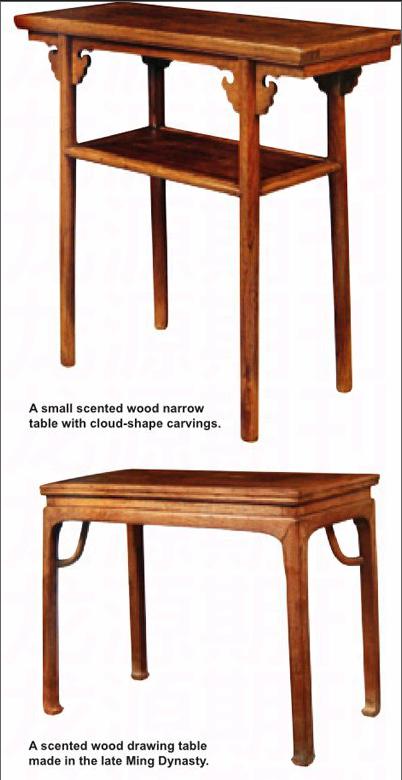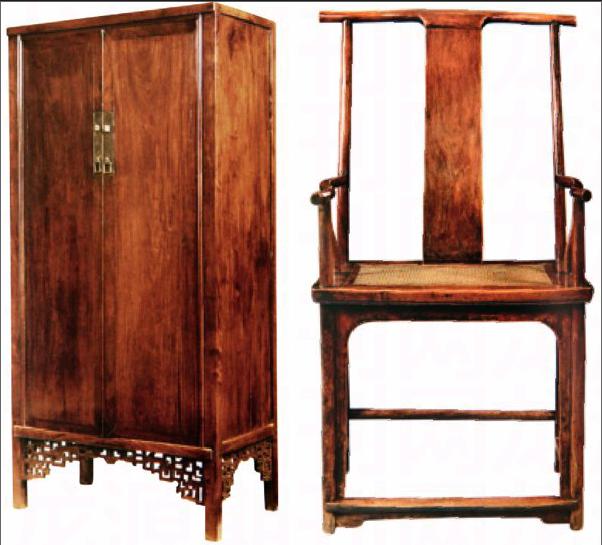The Foreign Ming-style Furniture Fascination
By+YI+LIN



WITH its fabulous shapes, unique historical value, and impeccable craftsmanship, Ming-style furniture enchants domestic and overseas collectors alike. Western collectors even hail it as furniture in its most perfect form.
Gustav Ecké, Pioneer Expert on Ming-style Furniture
In 1944, German national Gustav Ecké published Chinese Domestic Furniture in Photographs and Measured Drawings, which is regarded as the Bible of Ming-style furniture study among wood ware collectors.
Ecké came to China in the 1920s and taught at Xiamen University, Tsinghua University, and Fu Jen Catholic University. He achieved considerable attainments in the study of ancient Chinese jade ware, bronze ware, and drawings, and had an intimate association with famous Chinese architects Liang Sicheng and Liu Dunzhen. He even became one of the founding members of the Society for the Study of Chinese Architecture.
Ecké was obsessed with Ming-style furniture, and devoted to its collection and study. The English edition of Chinese Domestic Furniture in Photographs and Measured Drawings was published in Beiping (Beijing) in June 1944 when the city was occupied by Japanese invaders. Limited by the printing conditions of the time, only 200 copies of the book were printed.
In the 18th century, Chinese furniture spread to Europe and the United States. Eckés work presented the beauty of ancient Chinese furniture to the world, and also attracted the attention of domestic and Western furniture, architecture, cultural relics, interior design, and history circles. As well as the book, Ecké also published some significant papers on Chinese hardwood furniture.
Eckés Chinese wife, Zeng Youhe, had a profound love for traditional Chinese culture. Zeng once learned traditional Chinese painting from such masters as Qi Gong and Pu Xuezhai. While studying at Fu Jen Catholic University, she met Ecké. They soon fell in love and married. In 1948, the couple migrated to the United States. Due to his expertise in traditional Chinese art, Ecké was appointed to teach Art History of East Asia at Hawaii University.
Ecké died from a heart attack in 1971 aged 75. On September 20, 2006, Zeng donated their sevenpiece collection of Ming scented wood furniture to the Prince Gongs Mansion Management Center. Among all donated objects of Ming furniture since the management center formally began to solicit cultural relics from the public, Zengs donation stands out as having the highest academic value.endprint
Zeng said, “Im already in my 80s. Its better for me to leave the furniture to China, to the people.”
Robert Hatfield Ellsworth, King of Ming Furniture Collection
On March 7, 2015, the bidding at Christies in New Yorks Rockefeller Center on a pair of scented wood round-backed armchairs produced in the late Ming and early Qing dynasty started at US $2.2 million. The final transaction price was US $2.629 million, eight times the lowest estimated price, setting a new world auction record for scented wood furniture.
The contours and texture of the scented wood round-backed armchair fully display its elegance and exude a profound cultural aura. It was once collected by Robert Hatfield Ellsworth (1929-2013), a heavyweight collector of Asian art articles, known as the “King of Ming Furniture Collection,” for his treasure trove of Ming-style furniture.
Ellsworth devoted himself to the study and collection of Ming-style furniture for decades and produced prolific works on its study. In 1970, he made a great coup with the book Chinese Furniture (Hardwood Examples of the Ming and Early Ching Dynasty). In 1982, Ellsworth held a Chinese furniture exhibition at Honolulu Art Museum, and compiled a catalogue of exhibited Chinese hardwood furniture articles. In 1996, he privately published Chinese Furniture: One Hundred Examples from the Mimi and Raymond Hung Collection. In 1998, he published Essence of Style: Chinese Furniture of the Late Ming and Early Qing Dynasty. Ellsworth published his last work, Volume Two of Chinese Furniture: One Hundred Examples from the Mimi and Raymond Hung Collection, in 2005. Christies recent whopping auction price not only demonstrated Ellsworths important status as a connoisseur and collector of Chinese furniture, but also testified to his achievements in the study of Chinese furniture.
Undoubtedly, Ellsworth was endowed with a unique appreciation of Ming-style furniture. He not only generously shared his findings and knowledge, but also reminded others to sharpen their focus without being perplexed and disoriented by fleeting trends.
Ellsworth believed that people can disregard clichés on aesthetics and appreciate the real beauty of an object only if they trust their judgment instead of blindly following doctrines set by experts. He held that those who learn to observe by themselves automatically find paths into a new world and discover beauty and virtue different from traditional culture. Ellsworths study, zeal, unique insight, and generous contribution constituted a foundation for the Chinese furniture connoisseur and collection circle to develop further.endprint
Philippe De Backer, Back to the Ming Dynasty
Belgian Philippe De Backers “Lü Ming Shi” is the biggest private collection venue for Ming-style furniture outside China. Lü Ming Shi was named by the famous Chinese connoisseur and collector Wang Shixiang, literally meaning “to be a companion of the Ming collection.”
For De Backer, furniture is full of life. He holds that people must live among it if they want to fully appreciate its full beauty. His collected pieces of exquisite Ming-style furniture are his companions. He likes to spend time with these items of furniture and be taken back to the Ming Dynasty by their presence.
In 2006, De Backers 71 pieces of Chinese furniture were brought back to China when the Forbidden City hosted an exhibition of his collection at an event celebrating the 35th anniversary of the establishment of diplomatic relations between China and Belgium. In the spring of 2011, a special auction of all Lü Ming Shis Ming furniture was held by the China Guardian auction house, causing quite a sensation.
Experts from the Beijing Palace Museum confirm that De Backers profuse collection of Ming furniture, covering all categories, is well preserved and intact, and showcases exquisite workmanship. Therefore, De Backer has been named the collector and owner of most Ming scented wood furniture outside China.
In 1989, De Backer began to travel across China, visiting more than 30 Chinese cities, not to seek out furniture, but to experience Chinese culture. Due to the dwindling items of quality scented wood furniture in the hands of private Chinese owners, most of the items in De Backers collection are from overseas and Hong Kong.
Years of study led De Backer to the discovery that Ming-style furniture has had a great influence on Western furniture design. Some famous furniture designers have paid tribute to Ming-style furniture with their master strokes. Chair backs of English furniture designs have also absorbed elements of Ming furniture.
As for the popular opinion that literary men were involved in the design of Ming furniture, De Backer doesnt endorse it as he thinks there is no tangible proof. Since ancient Chinese furniture usually reflects the relationship between humankind and nature, literary men intended to present a modest and gentle image as well as their humbleness before nature in their furniture. However, the most expensive wood was used, thus forming an interesting paradox.endprint
“The East and the West are quite different in aesthetics. For example, in the West, to embody a persons nobleness, elaborate decoration will be used in furniture design. However, in China, the principle is less is more.”
Curtis Evarts, Seeking Plain Nature of Ming Furniture
Curtis Evarts is an American with a Chinese name, Ke Tisi (柯惕思), meaning clear thinking. Evarts is a collector and researcher of traditional Chinese furniture. The 1980s and 1990s saw the golden age of collection and research of Ming furniture abroad. Evarts is a witness of the collection fad.
In 1988, Evarts began to turn his attention to ancient Chinese furniture. He collected some hardwood Chinese furniture made of red sandalwood and scented wood, and was mesmerized. He visited major museums and libraries worldwide to check documents, seek pictures, and observe genuine ancient Chinese furniture. He even went to the hardwood furniture factory in Hong Kong several times to carry out on-the-spot investigation.
From 1990 to 1996, Evarts took the post of curator of a traditional Chinese furniture museum in California, which provided him with the chance to plan some significant collection activities on traditional Chinese hardwood furniture. From 1990 to 1994, Evarts also worked as an editor for a quarterly academic periodical on traditional Chinese furniture, to which he contributed many articles.
In 1997, Evarts moved to Taipei to further his study and work on traditional Chinese furniture. He planned Taiwans first exhibition of Ming and Qing furniture collections, which created an exchange craze among ancient furniture collectors and aficionados alike.
Now, Evarts sojourns in Shanghai, and independently carries out study and consultancy work in the field of ancient Chinese furniture. He even runs a traditional Chinese furniture store, Yi Shan Ju.
Otherwise, Yi Shan Ju is mainly engaged in academic exchanges, and cultural and art education. The stores business service is a sideline. Its name Shan Ju (Residence of Kindness) is from a wooden plaque in Huizhou. The name can be traced back to the text of Tao Te Ching, “The best virtue is like waters. Water benefits everything in the world but never contends its own contribution.”
Observers are intrigued as to how a foreign researcher like Evarts learns about ancient Chinese furniture. Apart from learning Chinese and reading English versions of Chinese books, Evarts collects a huge number of ancient woodblock prints. He observes the fine changes of furniture in the pictures of daily life in ancient China.
In Evarts view, the collected articles are similar to people: Each item of furniture has its own personality, sometimes its like a naive girl, sometimes like a lusty man. Evarts thinks that furniture, like people, is produced with a plain unvarnished nature but as time goes by, it absorbs elements around it, which changes its nature. He likes simple furniture with a good heart, in particular Ming-style furniture.endprint

